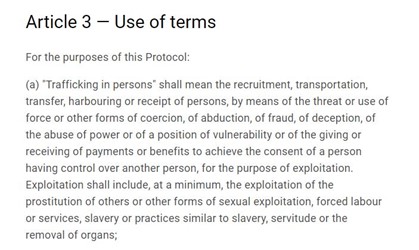
This article is the first part of a three-part series on human trafficking.
Anti-financial crimes (AFC) professionals are uniquely positioned to identify human trafficking operations through their financial footprints. AFC professionals can support criminal cases to mitigate the burden placed on victims and they can also facilitate the financial restitution process—ultimately decreasing the profitability of illegal trafficking while increasing accountability for the traffickers.
Accordingly, human trafficking is a predicate crime for money laundering in most countries, including the United States (U.S.). The Financial Crimes Enforcement Network (FinCEN) released its first-ever list of anti-money launder/countering the financing of terrorism (AML/CFT) national priorities, designating human trafficking as a priority issue, clearly signaling that it is critical that AFC professionals understand this complex issue.1
Defining the Problem
You may have heard terms such as “human trafficking,” “modern slavery,” “forced labor,” “child sexual exploitation,” and “debt bondage” but are not familiar with the precise definition of each, you are not alone. The exact terminology and definitions associated with these concepts differ by jurisdiction and in some instances, the concepts overlap. For many AFC professionals, a general understanding of these terms is sufficient. In this article, we will try to clear up some of the most common points of confusion.2
Human Trafficking
In situations of human trafficking, a person is forced, defrauded and/or coerced into providing labor, a service, or a commercial sex act. Commercial sex means sex in exchange for money or something of value and is commonly referred to as prostitution but may also involve the sale of non-consensual pornographic or sexual materials. In addition, any situation in which a minor (a person under the age of 18) engages in commercial sex is considered a situation of sex trafficking because minors do not have the ability to consent this activity.
In the U.S., the primary relevant legal definition to understand, is the definition in the 22 U.S. Code, Section 7102 (11) “Severe Forms of Trafficking in Persons,”3 see Figure 1.
All countries have legal statutes that criminalize this activity, but there are some differences in both the definition and the terminology used. For instance, sex trafficking and labor trafficking are defined separately in the U.S. but the primary international legal definition of trafficking in persons does not make this distinction. The international definition also references additional activities such as the removal of organs, according to the General Assembly resolution by the United Nations (see Figure 2).4 Organ trafficking is not referenced in the U.S. definition of human trafficking. Instead, this activity is explicitly criminalized in a different legal statute, the “Prohibition of organ purchases 42 U.S. Code, Section 274e.5
Figure 2: Protocol to Prevent, Suppress and Punish Trafficking in Persons Especially Women and Children

Modern Slavery vs. Human Trafficking
In the international arena, “modern slavery” is used as an umbrella term that covers a set of specific legal concepts pertaining to situations of labor, domestic and sexual exploitation that a person cannot refuse, leave, or quit because of threats, violence, coercion, deception, inability to consent and/or abuse of power.6 In some jurisdictions such as the United Kingdom (U.K.) and Australia, “modern slavery” is defined in the law. The legal definition of modern slavery in the U.K. and Australia closely align with the definition of severe forms of human trafficking in U.S. law, and trafficking in persons in international law. In the U.S., “modern slavery” is not a legal term, and the term is not used extensively to avoid conflating the current manifestation of this phenomenon with the historical legal institution of chattel slavery in which the state recognized one person’s ownership of another person.
Child Sexual Exploitation vs. Human Trafficking
“Child sexual exploitation” is also an umbrella term covering several forms of sexual abuse of children. In the U.S., the sexual exploitation of children is defined in 18 U.S. Code, Section 22517 and includes the following, see Figure 3:
So, while all situations of sex trafficking involving minors are considered child sexual exploitation, there are forms of child sexual exploitation that do not meet the legal definition of sex trafficking. These situations typically involve sexual abuse of children which is not commercial in nature -- for instance, when a person produces child sexual abuse materials (referred to as child pornography in federal law 18 U.S.C. § 2256 (8)) but does not sell these materials. Once again, this is a serious criminal act, but may not constitute sex trafficking.8
Human Smuggling vs. Human Trafficking
Despite FinCEN’s decision to list human smuggling and human trafficking together as an AML/CFT National Priority, these are, in fact, two very distinct crimes. While human trafficking means non-consensual work, labor, or commercial sex, human smuggling is the business of illegally moving people across international borders. In many instances, smuggling does not involve coercion as the people being smuggled have generally chosen to make the trip themselves for any number of reasons. There are instances in which a situation of smuggling may evolve into a situation of human trafficking. For instance, people being smuggled into the U.S. are sometimes coerced into some form of labor or commercial sex by their smugglers in order to pay off some debt associated with being smuggled. But these are distinct concepts. Human trafficking does not require travel, transportation, or movement of any kind.9
Scope of Human Trafficking
Because of the hidden nature of human trafficking, many victims of human trafficking are never identified. Data pertaining to the number of victims identified is often a better indicator of the level of awareness of the problem within a given community and availability/accessibility of support systems, than to the true scope of the problem. As such, it is difficult to estimate the true prevalence of human trafficking. In addition, depending on the definition used, estimates may vary widely. The best available estimates on the size of the problem come from the Global Modern Slavery Index, see Figure 4. This index was released by the International Labour Office and Walk Free Foundation, which used the broader concept of “modern slavery” but also included sub-estimates for specific concepts.10

Diversity of Human Trafficking
Because human trafficking is non-consensual participation in economic activity, it may involve any type of work, labor, service, or commercial sex activity. Accordingly, human trafficking is an incredibly diverse crime and may manifest differently depending on the geography. That said, there are identifiable patterns associated with human trafficking business models. In future articles, we will dive into the common business models and high-risk industries associated with sex and labor trafficking, financial red flag indicators associated with various forms of human trafficking and other key information.
Sara Crowe, strategic initiatives director, Financial Systems Polaris, Washington, DC, LinkedIn
Chris Bagnall, CAMS-FCI, CFE, LinkedIn
- “Anti-Money Laundering and Countering the Financing of Terrorism National Priorities,” fincen.gov, June 30, 2021, https://www.fincen.gov/sites/default/files/shared/AML_CFT%20Priorities%20(June%2030%2C%202021).pdf
- For legal professionals, law enforcement, and others who need more detailed information about the definitional distinctions between these terms see: “Fight Modern Slavery and Human Trafficking Part 1,” ACAMS, https://www.acams.org/en/training/certificates/fighting-modern-slavery-and-human-trafficking
- “22 U.S. Code § 7102 – Definitions,” Cornell Law School, Legal Information Institute, https://www.law.cornell.edu/uscode/text/22/7102
- “Protocol to Prevent, Suppress and Punish Trafficking in Persons Especially Women and Children, supplementing the United Nations Convention against Transnational Organized Crime,” United Nations, Human Rights Office of the High Commissioner, https://www.ohchr.org/en/instruments-mechanisms/instruments/protocol-prevent-suppress-and-punish-trafficking-persons#:~:text=(a)%20%22Trafficking%20in%20persons,giving%20or%20receiving%20of%20payments
- “42 U.S. Code § 274e - Prohibition of organ purchases,” Cornell Law School, Legal Information Institute, https://www.law.cornell.edu/uscode/text/42/274e#:~:text=It%20shall%20be%20unlawful%20for,the%20transfer%20affects%20interstate%20commerce
- For more information on the specifics of legal statues by country: “AntiSlavery in Domestic Legislation,” antislaverylaw, https://antislaverylaw.ac.uk/
- “18 U.S Code § 2251 – Sexual Exploitation of Children,” Cornell Law School, Legal Information Institute, https://www.law.cornell.edu/uscode/text/18/2251
- For more information on concepts related to child sexual exploitation, see “Human Trafficking: The Link to Child Sexual Exploitation,” ACAMS Today, https://www.acamstoday.org/human-trafficking-the-link-to-child-sexual-exploitation/
- For more information on this distinction, see FinCEN’s advisory released in October 2020: “Supplemental Advisory on Identifying and Reporting
Human Trafficking and Related Activity,” fincen.gov, https://www.fincen.gov/sites/default/files/advisory/2020-10-15/Advisory%20Human%20Trafficking%20508%20FINAL_0.pdf - “Global Estimates of Modern Slavery: Forced Labour and Forced Marriage,” International Labour Office, Walk Free Foundation, International Organization for Migration, https://www.ilo.org/wcmsp5/groups/public/---ed_norm/---ipec/documents/publication/wcms_586127.pdf












